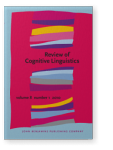Vol. 8:1 (2010) ► pp.207–221
The contribution of Herrero Ruiz’s Understanding Tropes to the interplay between Cognitive Linguistics and Pragmatics
A critical review
This article attempts to give a critical review of Javier Herrero Ruiz’s Understanding Tropes. At a Crossroads between Pragmatics and Cognition. It evaluates the book in view of the available literature dealing with the trend towards empiricism adopted by Cognitive Linguistics. It also focuses on the main hypothesis put forward, i.e., tropes such as irony, paradox, oxymoron, overstatement, understatement, euphemism, and dysphemism can be considered idealised cognitive models, and discusses the main contributions and arguments of the book, especially his idea that these idealised cognitive models are all constructed around the creation of contrast. A few concerns are also raised, mainly regarding corpus methodology. While these may have a negative impact on the reader, they are not severe enough to discredit the rigour with which the book was conceived.
